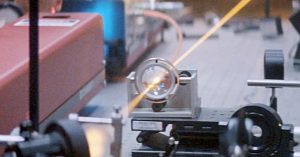This summer, Dishcraft released a new dishwashing robot. It’s only the latest invention that we’ll use in a way that threatens what I’m calling “on-ramp” jobs.
I loved being a dishwasher. Every summer for a few years in high school, I’d get up at 7 and walk half a mile from my house to a small breakfast joint. Don ran the place, Al was the cook, and Rick was backup. Compared to theirs, my job was dead simple: Take the dishes out of the bus trays, scrub them down, put them in a heavy-duty plastic rack, slide that into the dishwasher, wait until the cycle finishes, take out the cleaned tray, put the dishes away on a rack. And repeat—maybe 50 or 60 times a shift. Meanwhile I learned how to care for the machine, I enjoyed figuring out ways to do my job with fewer steps, I got to know Al and Rick, I heard their war stories, and I got a bit of an intuitive understanding of how our kitchen ran. That’s when Al asked me to step behind the oven.
WIRED OPINION
ABOUT
Matt Beane (@mattbeane) is an assistant professor of technology management at UC Santa Barbara and a research affiliate at MIT’s Institute for the Digital Economy.
On-ramp jobs like these (page, research assistant, receptionist) allow us to do something simple and useful in the middle of the action, get paid, build relationships, get a broader view on organizational operations, and make an educated decision about where to go next. My research shows that intelligent machines are sharpening a scalpel that will allow us to carve up work processes in the name of productivity, and that routine jobs are the first to go. Dozens of studies show automation’s looming effects in contexts as diverse as investment banking, policing, education, and internet startups. What’s going to happen to on-ramp jobs in this new world we’re creating?
Dishcraft’s system is a good example to think with. For large-scale dining operations, the company promises that its robot will allow for a significant reduction in the labor required to clean plates and bowls—which still is most of the work for those who do dishes. In a statement, Dishcraft founder and CEO Linda Pouliot wrote that the company’s “vision is to improve the role of dishwasher rather than replace it … Dishcraft is automating the dirty, dull, dangerous part of dishwashing, so it is a cleaner, safer, rewarding job that more people want to do.” The system reliably takes in a stacked tray of about 50 dishes, handles and cleans them internally, and sends them out to be reused. Like many robotic systems, it works because engineers made the job a lot more predictable. The ceramic plates and bowls are custom-built with stainless steel installed in them that allow a robotic scrubber to use magnets to quickly remove all debris. Then the dish is rotated to an “inspection station.” If Dischcraft’s AI vision algorithms determines it to be clean, it will move on to the next stage; if the AI deems it dirty, it will be cleaned again.
That “making the job more predictable” bit extends well beyond the focal washing task. To take advantage of the system, spaces and other equipment need to be reconfigured to make room for the robot and for cart transit routes, workers have to learn to perform more specialized, repetitive tasks like loading and unloading the carts and the robot, assignments need to shift to balance and connect these more granular jobs throughout the facility, and new policies and safety procedures have to be instituted. Decades of research decisively show the same pattern: Organizations have to expend massive effort overhauling preexisting facilities, workflows, and norms just to get new forms of automation to function, let alone deliver a satisfactory return.
Whether it involves thousand-pound, million-dollar robots or intangible, freemium software, new automation is going to mean fewer on-ramp jobs in cities. Business reconfiguration expenditures will be worth it only for large businesses that have many staff and highly standardized processes, which are overwhelmingly located in urban areas. Small businesses don’t have the volume to justify this kind of investment, and there’s too much variation in the work (e.g., handling different types of plates, bowls, and cutlery differently) for this generation of technologies to handle.
This could deepen the wealth and opportunity chasm that has been opening up in urban areas. MIT’s freshly minted “The Work of the Future” report pulls together a great deal of superb recent research to show that, since the 1970s, less-educated workers have seen less and less opportunity in cities, even though many social scientists expected the demands for their services should be increasing. A technologically driven reduction in on-ramp jobs could deepen this chasm twice: in the short run by eliminating routine jobs, and by eliminating critical opportunities for new workers to build skill and opportunity.
Automation-driven changes in on-ramp jobs might mean more for organizations and more experienced employees than it does for the on-ramp employees themselves. In our current economy, many organizations are public about their struggle to find qualified talent and are working ever harder to retain the talent they have. They’re spending more on programs to educate their workforces, build connections with educational institutions and ensure fair hiring, development and promotion practices. So far, however, they have also invested billions in intelligent technologies, hoping for productivity and competitive advantage while redesigning work to eliminate on-ramp jobs. It’s not obvious the short-run gains are worth the talent drain, but it’s hard to see this trend changing.
And while they will probably become more productive in the short run, experienced employees lose here too. Don, Al, and Rick counted on me for more than clean dishes. I could help them on their main tasks in a pinch: get a plate to the window, whisk 80 eggs. That prepared me to step up if they left or just wanted a day off. They could also informally mentor me and answer my naive questions—an important way of keeping themselves sharp and taking pride in their skill and experience. And on a human level, they wouldn’t otherwise have run with someone like me, and I wouldn’t have otherwise run with people like them. It made all of our work more interesting, and I know it taught me empathy.
We can do better than the automation status quo. First off, I’ve shown that somewhere, we probably already are: A scant few are bending and breaking rules to keep the benefits of on-ramp jobs while adapting to work involving intelligent technologies. We need to find these people and learn from them. Beyond this, we need to take a stand. Any of us—worker, manager, technologist, policymaker—can look for ways to handle the technologies that both preserve the benefits of on-ramp jobs and deliver the productivity gains we’re all hoping for. We could create new, even-more-valuable on-ramp jobs that are possible only because of intelligent technologies, for example. Some kitchens that buy the Dishcraft system will probably realize they could get more customers by showing it off through a plexiglass wall in the hallway on the way to the conveyor where you drop your tray. They’ll need someone to keep the wall and the robot clean and answer bystander questions. That’s the beginnings of an on-ramp job, and I bet many a high-schooler would jump at the chance.
WIRED Opinion publishes pieces written by outside contributors and represents a wide range of viewpoints. Read more opinions here. Submit an op-ed at opinion@wired.com
More Great WIRED Stories
- The tech helping dogs learn to “talk” with humans
- Don’t you dare call the Microsoft Surface Duo a phone
- Inside Pioneer: May the best Silicon Valley hustler win
- Surveillance and the Ringification of suburban life
- How cities reshape the evolutionary path of urban wildlife
- 👁 If computers are so smart, how come they can’t read? Plus, check out the latest news on artificial intelligence
- 🏃🏽♀️ Want the best tools to get healthy? Check out our Gear team’s picks for the best fitness trackers, running gear (including shoes and socks), and best headphones.


